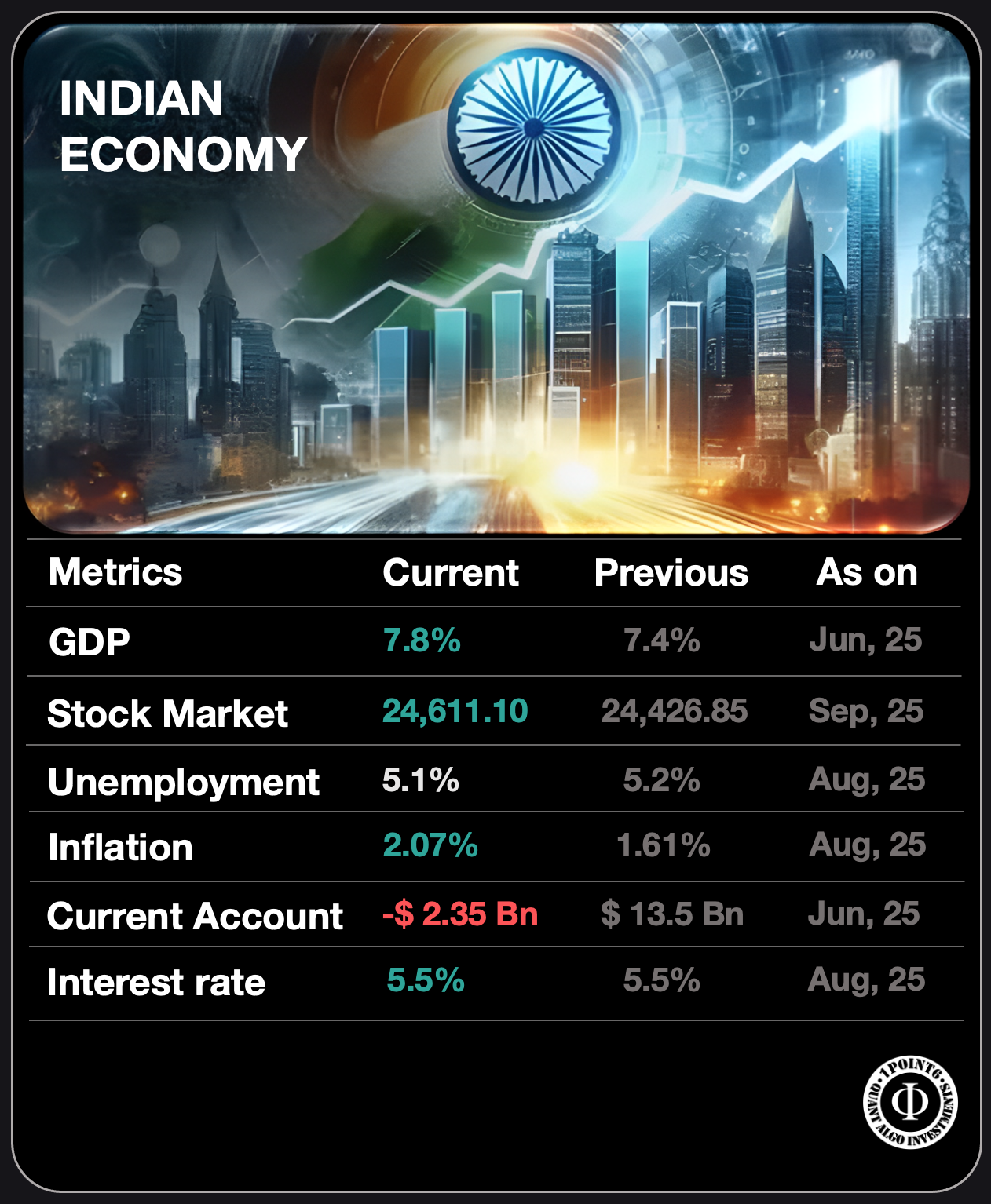Indian economy metrics
Key economic metrics of India as of now, including GDP growth, stock market performance, unemployment rate, inflation, current account balance, and interest rate, highlighting the current economic status, trends, and changes from previous periods.
Task
To gauge and ascertain the economic health based key metrics and indicators.
-
Objective
Economic health
-
Strategy
Economic metric analysis
-
Time Period
2025-2026
Indian Economic Analysis & Outlook (2025-26)
🇮🇳 Indian Economy Snapshot – Sept 2025
1. Macro Snapshot & Recent Performance
Growth & Output
In FY 2024-25, India’s real GDP growth was ~6.5%.
Q4 of FY25 expanded more strongly (~7.4%), helping offset softness earlier in the year.
Growth forecasts for FY 2025-26 remain in the 6.3–6.7% band, with institutions like OECD upgrading to ~6.7%, while IMF estimates ~6.4%.
The projection for FY 2026-27 is slightly higher (~6.4%), reflecting modest upward momentum in investment and consumption.
Inflation & Monetary Conditions
Inflation is moderating, with expectations that it will stay around 4.0–4.1% in FY26 as headline pressures ease and core inflation stabilizes.
With inflation more benign, the RBI has some room to ease policy or shift to a more neutral stance as needed.
Fiscal & Debt Metrics
The government aims to gradually reduce the fiscal deficit from ~4.8% of GDP (FY25) to about 4.4% in FY26 through better tax collections and controlled expenditure.
Capital expenditure (capex) is being prioritized, with faster growth in government capital outlay to support infrastructure and multiplier effects.
Public debt is under watch, but the focus is on maintaining sustainable levels and avoiding undue burden.
External Sector, Trade & Capital Flows
The current account deficit (CAD) is expected to remain benign, in the ~1% of GDP range or lower, aided by relatively favorable oil prices, strong services exports, and controlled trade deficits.
Foreign exchange reserves remain robust, providing buffer against external shocks.
Export growth may face headwinds from global slowdown and rising trade protectionism, especially tariffs from major trading partners.
Structural Indicators & Reforms
Demographically, India has a young workforce and favorable dependency ratios — a long structural tailwind if capitalized.
The government continues pushing reforms in taxation (GST tweaks), privatization, infrastructure, energy transition, and labor regulation.
Sectors like digital infrastructure, renewable energy, manufacturing, biotech, and advanced technology are being identified as future “arenas” for growth.
2. Key Growth Drivers & Enablers
Consumption & Rural Demand
As inflation moderates and rural incomes stabilize (aided by good monsoon and agri output), consumer demand — especially in semi-urban and rural India — is expected to firm up.
Lower-income groups (who consume a larger share of essentials) will benefit from stable food prices, helping aggregate demand.
Government Capex & Infrastructure Push
Continued public investment in roads, railways, ports, urban infrastructure, power & transmission, and green energy is central to the growth plan.
Capex acts as a multiplier — supporting demand for steel, cement, machinery, construction, and associated supply chains.
Private Investment & Corporate Capex
With better capacity utilization and improving balance sheets, companies may resume expansion plans, especially in sectors like chemicals, electronics, industrial goods.
Lower interest rates (if achieved) and better credit flow will help in this revival.
Services & Digital Economy
India is strong in services (IT, business services, financial services). As global demand recovers, exports of services could cushion goods export weakness.
The digital economy, fintech, AI/ML applications, data centers, cloud, clean tech — these are likely to be big growth engines over the next decade.
Energy & Green Transition
Push toward solar, wind, battery storage, green hydrogen, and cleaner energy infrastructure.
Investments in grid modernization, energy storage, and decarbonization will open up opportunities across sectors.
FDI, Global Supply Chains & Nearshoring
India is trying to attract manufacturing and supply chain relocation from China and Southeast Asia.
Incentives (PLI schemes, export incentives) and better ease-of-doing-business improvements are key to capturing that.
Trade agreements (bilateral / multilateral) and export access will be important for deeper integration into global value chains.
3. Risks, Constraints & Headwinds
Global Slowdown & External Shocks
Weakness in global demand — particularly from the US/Europe — will put pressure on Indian exports.
Rising global rates or tightening in advanced economies may reverse capital flows or raise cost of external borrowing.
Tariff shocks or trade protectionism from key trading partners could hurt competitiveness of Indian goods.
Commodity Prices & Inflation Shocks
A spike in crude oil, metals or food commodity prices could push inflation up and squeeze margins in industry, as well as reduce consumers’ real incomes.
Inflation surprises limit space for monetary easing and can provoke rate hikes.
Fiscal Stress & Revenue Slippages
If tax revenue collections underperform (especially after any tax cuts or GST rate changes), fiscal consolidation may be tougher.
Subsidy burdens, loan waivers, or unplanned expenditures could strain the budget.
Structural Bottlenecks & Implementation Risk
Land acquisition, clearances, regulatory bottlenecks, labor rigidities, weak logistics, and infrastructure gaps still constrain faster growth.
Delays or cost overruns in infrastructure projects could diminish the multiplier effect.
Skill mismatches and gaps in education/health infrastructure may limit productivity gains.
Climate & Energy Risks
India is vulnerable to climate shocks (droughts, floods) that can affect agriculture, rural incomes and infrastructure.
Transitioning from coal to cleaner energy requires large investments; missteps or delays could raise costs or energy shortages.
4. Growth Scenarios & Outlook (2025–2030)
Base case (most likely)
India grows ~6.3–6.7% per year in FY26 and FY27, gradually converging to ~6–6.5% beyond that.
Inflation remains ~4%, allowing some monetary flexibility.
Capex and private investment become stronger drivers, balancing consumption-led growth.
India continues to attract foreign capital, integrate into global supply chains, and build on reforms, while external volatility and protectionism remain tail risks.
Upside scenario
Manufacturing / industrial revival accelerates, exports pick up strongly, and supply-chain shift to India intensifies.
Successful energy transition and digital infrastructure growth drive high-multiplier growth.
Major structural reforms (labor, tax, logistics) unlocked, productivity surge follows.
Under this, India could average growth of 7–7.5% for a prolonged period, pushing it up global GDP rankings.
Downside / stress scenario
Global recession, sharp commodity price spikes, or persistent inflation lead to monetary tightening, weakening demand.
Fiscal slippage and stressful public debt markets create macro instability.
Exports shrink due to trade barriers.
Structural bottlenecks or weak reforms stall growth to ~5% or lower for a period.
5. Forecast Risks & Monitoring Indicators
Key indicators to watch
Monthly industrial production, PMIs (manufacturing & services)
Goods & services export growth, trade balance
Credit growth / bank lending data
Inflation (CPI & core), food price trajectories
Fiscal revenue datasets (GST collections, tax collection)
Capital expenditure trends in Union & States
Foreign capital flows (FDI / FII) and exchange rate movements
Energy prices, commodity cycles, and external borrowing costs
Risk flags
Inflation surprises or commodity shock forcing rate reversal
Large fiscal slippages or subsidy burden
Global demand slump or trade protectionism
Project implementation falters (infrastructure delays, cost overruns)
Environmental or energy crises — water stress, climate shocks
6. Long-Term Growth Prospects & Strategic Imperatives
To hit development goals by 2047, India must lean heavily on productivity gains, capital deepening, technology adoption and institutional reforms.
The 18 “arenas” (digital health, autonomous vehicles, next-gen manufacturing, biotech, etc.) described in strategic studies may contribute disproportionately to incremental GDP.
For sustained 7%+ growth over decades, India must bridge gaps in education, logistics, health, energy, climate resilience, and governance quality.
Global integration (trade pacts, investment treaties) is critical, but India’s ability to defend against external volatility and preserve buffer strength (external reserves, low debt, flexible policy) will matter a lot.
7. Conclusion
India’s economic performance through FY2025 and into FY2026 is characterized by resilience, moderation, and structural continuity. Growth is stabilizing after pandemic-era volatility, with inflation easing, fiscal consolidation in process, and reforms still underway. The balance is tilting toward a capex- and investment-driven growth phase, with consumption as an anchor.
While global headwinds, commodity shocks, and policy risks loom, India has built reasonable buffers — strong reserves, manageable external exposure, and a young growing population — which provide flexibility. If structural reforms and implementation sustain momentum, the next 5–10 years could see India achieving consistent ~6–7% growth, moving closer to its long-term vision.

